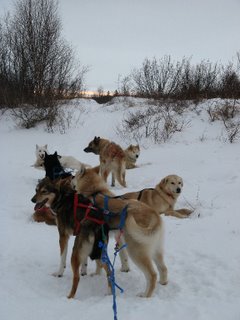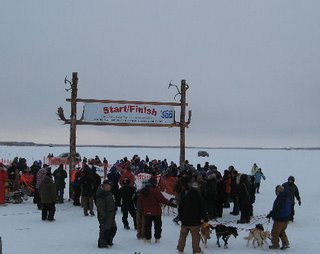 OK. Maybe I’m not quite done writing about dog mushing just yet. After a week of daily posting and very few comments, I had concluded that Tundra Medicine Dream readers were simply not too interested in the subject. I received a wonderful bolster of support from #1 Dinosaur at Musings of a Dinosaur this morning, and it was greatly appreciated. Dutch also pointed out, “blogs are for writing about whatever you want, and people can choose to read it or not. That’s the beauty of them.” I am still deeply involved in dog energy today, so here is the final wrap-up for a great K300.
OK. Maybe I’m not quite done writing about dog mushing just yet. After a week of daily posting and very few comments, I had concluded that Tundra Medicine Dream readers were simply not too interested in the subject. I received a wonderful bolster of support from #1 Dinosaur at Musings of a Dinosaur this morning, and it was greatly appreciated. Dutch also pointed out, “blogs are for writing about whatever you want, and people can choose to read it or not. That’s the beauty of them.” I am still deeply involved in dog energy today, so here is the final wrap-up for a great K300.
As of this morning, there were still two mushers out on the trail, Ben Bruce and David Fitka. They were traveling together and taking long rests, which suggests pretty tired dogs. As long as they complete the course, they will receive prize money, as the K300 pays the first twenty mushers and this year’s race only had nineteen teams.
Most of the 17 mushers who finished the race before the banquet left Bethel on the early plane this morning, including Aliy. We were up at 4:30 am to load her dogs, the sled and the dog kennels into three trucks and deliver them to the airport by 6 am. I came home to a quiet house and a long snow trench empty of sled dogs. It felt a little like a whirlwind had just passed through. The Big Dog and the Little Dog both wonder where their new friends went to.
 In the early afternoon, word came from race headquarters that Ben was expected at the finish line about 4 pm. Henry, Joan, Angela, Sean and I were down on the river to greet him.
In the early afternoon, word came from race headquarters that Ben was expected at the finish line about 4 pm. Henry, Joan, Angela, Sean and I were down on the river to greet him.
.
Ben runs his kennel in Bethel as an animal rescue operation. He takes pound dogs and tries to train them to be sled dogs. He manages to find homes for many of the dogs which don’t work out on the gangline. At the pre-race drawing for position, Ben brought one of the pups he is currently trying to place, and talked about his program. The pup was adorable, about 3 months old, and probably going to be quite a large dog if her feet and forelegs are any indication. I sat next to him at the meeting and handled her a bit. She is pretty serene for a puppy of that age, and paying attention to everything. It may be a case of puppy-love-at-first-sight. I’m planning to visit her at his kennel tomorrow; if Dutch likes her as much as I do, she may have a new home.
.
 Ben crossed the finish line at 4:15 pm with all 14 dogs on his gangline. He was the only musher who did not drop a single dog. His dogs looked tired but in good condition, and adequately rested. He looked very cold.
Ben crossed the finish line at 4:15 pm with all 14 dogs on his gangline. He was the only musher who did not drop a single dog. His dogs looked tired but in good condition, and adequately rested. He looked very cold.
Our gentle temperatures of the weekend (+10 to +20F) came to an end yesterday. It was zero when we awoke, minus 10 by afternoon, and minus 20 by midnight. Today the thermometer here has stayed on minus 20 all day. That is pretty cold for an exhausted musher and dog team who have been on the trail for 4 days. Ben passed on my offer to load the team in my truck and drive them to his house; he pulled the hook and said “Let’s go, dogs, get up there, you’re almost home!” He mushed his dogs down the river in the direction of his dog yard.
 That left one musher still on the trail, David Fitka, who would be the Red Lantern. He is a Native musher from the Yukon village of Marshall, and he ran the entire K300 with only ten dogs.
That left one musher still on the trail, David Fitka, who would be the Red Lantern. He is a Native musher from the Yukon village of Marshall, and he ran the entire K300 with only ten dogs.
He arrived in Bethel with twelve dogs, but one died tragically the day before the race, and a second was found by the vets to be too far advanced in pregnancy to be safe to compete. This was the result of an unintended breeding, and David had not been aware of it.
The K300 is a long race to start with only ten dogs, but his team comes from very strong village stock, with powerful bodies and very thick fur, and he had confidence that they could do it. He dropped three dogs in the last 50 miles of the race; the seven who finished looked great, strong and vigorous.
 David crossed the finish line at 6:52 pm this evening, officially ending the 2007 Kuskokwim 300. Not a single musher scratched this year, which is unusual. All the mushers agreed that this was one of the finest years for both weather and trail conditions in recent memory. Most of the mushers stated that they plan to be back next year. Dutch and I encouraged Aliy to consider bringing two teams next year so that both she and her husband Allen could run the race. She said she’d think about it.
David crossed the finish line at 6:52 pm this evening, officially ending the 2007 Kuskokwim 300. Not a single musher scratched this year, which is unusual. All the mushers agreed that this was one of the finest years for both weather and trail conditions in recent memory. Most of the mushers stated that they plan to be back next year. Dutch and I encouraged Aliy to consider bringing two teams next year so that both she and her husband Allen could run the race. She said she’d think about it.
So the exciting and energizing K300 Week draws to a close. This entire thing is a huge event in Bethel. It is a shot of adrenaline to the town, both economically and culturally. The dog energy around town is phenomenal; I estimated something in the neighborhood of 400 visiting sled dogs for these races. Lots of Bethel residents are volunteers (it takes an army!) and there is dog talk happening everywhere you go. For this week each year, Bethel is dog crazy.
Not only are there just lots of dogs, there are also a lot of famous mushers. The K300 roster each year reads like a “Who’s Who” of professional mushers. Kids run around at the banquet asking them to sign autographs on their sweatshirts.
The pros consistently say that the K300 is the best planned, best organized, best run mid-distance sled dog race in Alaska. It has the highest purse of any mid-distance race; only the Iditarod pays more. And one musher, who has run most (if not all) of the dozen or so other mid-distance races in the state, said that the K300 is also the hardest race of them all. Depending on the weather, it isn’t always fun; last year was brutally cold. This year everyone had a blast.
Photos by The Tundra PA. Finish Line awaits the Red Lantern at 6 pm. Ben Bruce and puppy at the pre-race drawing. Ben crossing the Finish Line. Cold Ben. David Fitka at the pre-race drawing. Unfortunately, the Finish Line photos of David were too dark and blurry to post.
Labels: Dog Mushing












































